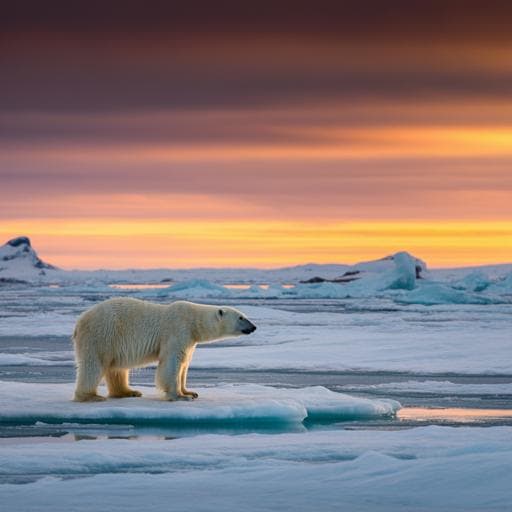
Earth Sciences
Ice-free period too long for Southern and Western Hudson Bay polar bear populations if global warming exceeds 1.6 to 2.6 °C
J. Stroeve, A. Crawford, et al.
Discover how Hudson Bay's warming climate is impacting polar bear hunting and survival, extending the ice-free period with dire consequences. Researchers, including Julienne Stroeve and Ian Stirling, reveal alarming projections that could lead to species extirpation if global temperatures exceed 1.6-2.6°C, while holding at 2°C may provide respite for adult polar bears as recruitment struggles against the longer ice-free seasons.
~3 min • Beginner • English
Introduction
Hudson Bay is a seasonally ice-covered inland marginal sea that supports a large polar bear population which relies on sea ice to hunt seals. Each summer, sea ice retreat forces bears ashore to fast until freeze-up. Historically, fasting lasted about four months (~120 days), but rapid regional warming has extended the ice-free period (IFP), reducing hunting time and contributing to declines—especially in Western Hudson Bay (WHB). Satellite observations show IFPs in Hudson Bay averaged ~128 days (1979–2014), with regional variability. Population assessments indicate accelerating declines in WHB (27% loss 2016–2021 vs 11% in 2011–2016), with fewer adult females, young bears, and cubs, and roughly half as many bears compared to 1987. The study aims to reassess future IFP and associated survival implications for WHB and Southern Hudson Bay (SHB) using updated CMIP6 projections and a more realistic habitat definition.
Literature Review
Earlier studies linked earlier sea-ice breakup with reduced survival and population size of polar bears in WHB and elsewhere. Observational work shows polar bears depend heavily on ringed seal pups in late spring/early summer for annual energy intake, making spring breakup timing crucial. Prior modeling studies often related population metrics to sea ice extent thresholds; more recent work (e.g., Molnár et al. 2020) established fasting season length thresholds for persistence and adult male survival. Passive microwave SIC products (Bootstrap, NASA Team) provide long-term phenology but have known biases, particularly during melt/freeze transitions. CMIP6 models have documented sea-ice climatology biases in the Hudson Bay complex, often overestimating IFP duration, though many capture trends due to offsetting biases in warming rate and sensitivity. Snow depth over sea ice is a critical factor for ringed seal pup survival; literature shows lair formation needs sufficient drifted snow (~>32 cm depth), and early rain events can collapse lairs and dens, threatening both seals and bears.
Methodology
Observations: Sea ice phenology was derived from passive microwave satellite SIC products (Bootstrap and NASA Team) at 25-km resolution from Oct 1978–present. A 5-day moving average was applied. For each year and grid cell, retreat was the last day SIC fell below 10% in summer; advance was the first day SIC rose above 10% in autumn; IFP is the continuous period with SIC <10%. Due to the lack of daily thickness observations spanning all seasons, SIC was used for the observational period. Global annual mean surface temperature came from the Berkeley Earth Surface Temperatures (BEST) dataset. Snow depth was assessed using the SnowModel-LG product (MERRA2-forced), focusing on April.
CMIP6 models: Twenty CMIP6 models (historical + SSP5-8.5) with daily SIC and sea-ice thickness were used (first ensemble member where possible). Two IFP definitions were tested: 10% SIC (matching the observational approach) and 10 cm sea-ice thickness. The 10 cm thickness threshold, motivated by frazil ice scheme minima and polar bear habitat plausibility, better matched observed IFP averages (reduced bias) than 10% SIC. Trends (ΔIFP/Δt) and temperature sensitivity (ΔIFP/ΔT) for 1979–2021 were computed via OLS regression; internal variability was estimated as two times the standard deviation from a 30-member ensemble (MPI-ESM1-2-LR). Retreat and advance were not computed in cells with year-round ice-free conditions at high warming; spatial averages of IFP can thus slightly exceed average advance-retreat differences.
Bias adjustment and weighting: Two projection approaches were implemented: (1) Bias-adjusted average of 20 single-member simulations. Bias (B_mx) for each model and region was computed by comparing model IFP to observed IFP over years with BEST global temperature in the observational range (0.42–1.33 °C relative to 1850–1900), then subtracting B_mx from model IFP to produce IFP_adj,mx, preserving model trends while anchoring to observed climatology. (2) Performance- and independence-weighted average of 49 simulations (from up to seven members per model), using a Gaussian weighting based on distances to observations (D_i) and inter-simulation distances (S_ij) across 16 normalized variables (regional temperature averages/trends and IFP/retreat/advance temperature sensitivities for SHB and WHB). Parameters used were σ_D = 0.49 and σ_S = 0.50, chosen based on perfect-model experiments to balance performance emphasis and uncertainty representation, and to avoid overfitting to a single model (MRI-ESM2-0). Weighted mean and standard error were computed from normalized weights. Snow depth projections used only the bias-adjusted averaging because satellite and reanalysis trends disagree, precluding robust weighting.
Calibration to fasting: IFP was related to onshore/offshore dates from polar bear satellite telemetry (Cherry et al. 2013) to translate IFP into fasting period equivalence. Literature-based thresholds for adult male survival and recruitment were applied to projected IFPs to infer demographic risks.
Scenarios and framing: Projections are presented as functions of global mean temperature anomaly relative to 1850–1900, enabling comparison across scenarios (SSP5-8.5 primarily, but results expressed by warming levels).
Key Findings
Observed changes (1980s to 2012–2021):
- Surface air temperature increased by ~1.0–1.4 °C regionally (e.g., SHB ~1.0–1.2 °C; WHB ~1.1–1.4 °C; significance p<0.05 in many areas).
- Ice-free period (IFP) lengthened by 24–34 days in SHB and 28–31 days in WHB (algorithm-dependent), with Hudson Bay-wide IFPs in many areas reaching ~140–150+ days in the recent decade.
Model performance and bias:
- Using 10% SIC in models overestimates IFP by ~50 days on average relative to satellite estimates; using 10 cm thickness reduces the multi-model mean bias to ~30 days.
- CMIP6 multi-model mean trends in IFP over 1979–2021 align with the lower bound of observed internal variability, but for compensating reasons: models’ IFP sensitivity to global temperature is generally weaker than observed, while historical global warming is often overestimated.
Future IFP projections by global warming level (bias-adjusted first; weighted average in parentheses):
- At ~0.5 °C (early historical baseline), both regions start near ~120 (120) days.
- At 1.0 °C: SHB ~140 (150) days; WHB ~140 (140) days; WHB tends to retreat/advance ~1–2 weeks earlier than SHB.
- At 1.5 °C: SHB ~155 (170) days; WHB ~150 (155) days.
- At 2.0 °C: SHB ~175 (180) days; WHB ~165 (170) days. Retreat shifts to late June (early July); advance to mid-December (early January in SHB; late December in WHB, weighted).
- At 4.0 °C: SHB ~255 (280) days; WHB ~220 (240) days. SHB retreat in early May (late May); advance mid-January (mid-February); WHB retreat before June (around June); advance early January (late January). Uncertainty at 4 °C: SHB ±63 (±61) days; WHB ±43 (±44) days.
- Spatial gradient intensifies with warming: at 2 °C, east–west IFP difference ≈1 month; at 4 °C ≈2 months. Southeastern Hudson Bay exceeds 300 ice-free days at 4 °C in places.
Snow depth over sea ice (April):
- CMIP6 multi-model mean matches observed spatially averaged April snow depth without adjustment; gradient of thicker snow SE to thinner NW is reproduced, though central SHB is too thin and James Bay/SE HB too thick in models.
- Projected declines: WHB ~2 cm per °C; SHB ~3–4 cm per °C. At 1 °C: WHB ~11 cm; SHB ~17 cm. At 4 °C: WHB ~7 cm; SHB ~6 cm, implying reduced suitability for ringed seal birth lairs (snow depths <32 cm associated with decreased pup survival).
Demographic thresholds and risks:
- Adult male survival impact thresholds estimated between 183 and 218 IFP days, with the lower end (≈183 days) more relevant today due to declining body condition.
- Global warming limits for sustaining adult males using the lower threshold: SHB ≈2.1 °C (1.6 °C weighted) and WHB ≈2.6 °C (2.2 °C weighted). Without bias correction/weighting, thresholds would be even lower (≈1.5 °C SHB; ≈2.0 °C WHB).
- Recruitment impacts likely already: after ≈135 IFP days (≈117 fasting days), cub recruitment is reduced; scenarios with spring breakup 1–2 months earlier than the 1990s could cause 40–73% and 55–100% reproductive failure in females, respectively. Such conditions have occurred frequently since the late 1990s.
Population context:
- WHB population has continued declining, with sharper losses in 2016–2021; total numbers are about half of 1987 estimates (618 vs 1185, noting methodological differences). SHB also shows recent declines in body condition and a ~17% decrease in numbers (2011–2016).
Discussion
By reframing sea-ice habitat with a thickness threshold and correcting model biases, the study links projected IFP extensions directly to polar bear energetic limits and demographic thresholds. The results indicate that keeping global warming near or below ~2 °C could prevent average IFPs in SHB and WHB from exceeding ~183 days, a critical adult male survival threshold, though local areas may still surpass it. However, the analysis highlights that recruitment has likely been compromised already in both regions due to extended IFPs since the late 1990s, implying long-term population declines even if adult male survival remains viable at lower warming levels. The timing of ice loss matters: earlier spring breakup has outsized negative effects because bears depend on abundant, vulnerable ringed seal pups then, whereas delayed autumn freeze-up is less detrimental per day. Snow depth declines and increased rain events further threaten ringed seal pup survival and polar bear den stability, compounding risks from longer IFPs. Compared to WHB, SHB historically retained ice slightly later into summer, moderating impacts, but projections show SHB IFPs increase faster with warming and with greater uncertainty, suggesting converging risks. Overall, the findings reinforce that exceeding ~2–2.5 °C of global warming will likely render IFPs too long to sustain adult polar bears in Hudson Bay, with recruitment failure potentially driving earlier population collapse.
Conclusion
This study advances projections of polar bear habitat in Hudson Bay by: (1) introducing a sea-ice thickness-based definition of IFP that better reflects hunting habitat; (2) applying bias adjustment and performance-independence weighting to CMIP6 outputs; and (3) expressing projections by global warming levels to provide scenario-agnostic thresholds. Key conclusions are that limiting global warming to around 2 °C could keep regional average IFPs below critical adult male survival thresholds in SHB and WHB, whereas warming of ~3–4 °C produces IFPs (≈220–280+ days) incompatible with adult survival and sustainable populations. Given current trends and recruitment sensitivity at much shorter IFPs (~135 days), extirpation risks for these subpopulations are already elevated. Mitigation to reduce fossil fuel use, alongside conservation and adaptation planning for local communities and ecosystems, is essential. Future research should refine thickness-based habitat metrics at finer scales, improve snow depth and rain-on-snow observations and modeling in Hudson Bay, and integrate demographic models with updated habitat projections to quantify extinction risk timelines and management levers.
Limitations
- Observational constraints: Lack of daily sea-ice thickness records necessitated using SIC-based IFP for the historical period; passive microwave SIC has known biases during melt/freeze and coastal zones. Telemetry-based fasting calibrations are limited to specific years.
- Model biases: CMIP6 generally overestimates mean IFP and underestimates temperature sensitivity; bias correction anchors climatology but cannot remove all structural errors. Weighted averaging mitigates, but does not eliminate, model dependence and tuning-to-observations risks; parameter choices (σ_D, σ_S) affect results.
- Spatial resolution: Coarse model grids may miss coastal phenology, landfast ice processes, and fine-scale ice roughness that influence bear access and seal lair formation.
- Snow depth uncertainty: Satellite- and reanalysis-based snow depth products disagree on trends; SnowModel-LG performance is not validated in Hudson Bay due to limited in situ data. Translating mean grid-cell snow depth to lair-scale suitability is uncertain, especially under changing ice roughness and rain-on-snow events.
- Ecological thresholds: Survival and recruitment thresholds are derived primarily for adult males and from prior periods; declines in body condition shift thresholds downward, but exact current values and sex/age-class differences are uncertain.
- Scenario framing: While projections are expressed by global warming levels, much of the model data uses SSP5-8.5; extrapolation to other pathways assumes similar temperature–IFP relationships.
Related Publications
Explore these studies to deepen your understanding of the subject.







